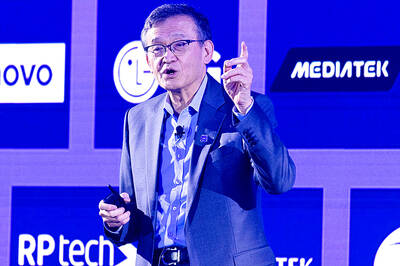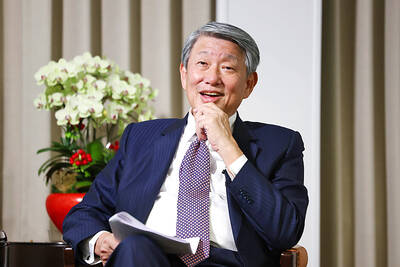Volvo Car Group plans to export a Chinese-made midsize sedan this year to the US, and is starting to weigh the possibility of building a vehicle factory in the US, people familiar with the Chinese-owned automaker’s plans said.
Both moves would be significant for the auto industry and Volvo’s parent, Zhejiang Geely Holding Group (浙江吉利控股集團). So far, global automakers have chosen not to ship vehicles made in China to the US market in any significant numbers, and efforts by Chinese automakers to export vehicles to the US have foundered.
Volvo is also behind rivals BMW and Mercedes in establishing production in the US, which insulates the German brands from currency fluctuations.
Volvo might also export a large “strategic, flagship” sedan based on a newly developed underpinning technology, said the executives, who work for Zhejiang Geely. That car would be shipped out of China in addition to the Volvo S60L, a long-wheelbase version of the S60 sedan Volvo began producing in the southwestern Chinese city of Chengdu more than a year ago.
The moves are aimed at reviving Volvo’s momentum in the US market, where volume last year fell 8 percent from 2013 to 56,371 vehicles. The US market, which has long been Volvo’s largest market, was replaced by China last year. China bought 81,221 Volvos last year, a 33 percent rise from 2013.
More broadly, the moves are part of Geely’s turnaround strategy for Volvo, which has struggled to go beyond being a brand with an annual volume of less than 500,000 vehicles. Thanks to its focus on China, where the brand expanded its distribution network and product portfolio, Volvo sales volume is on the rise. It sold a total of 465,866 vehicles globally last year, up 9 percent from 2013.
“The S60L offers class-leading rear space, something that has been consistently demanded by US customers. It will be made at Volvo’s plant in Chengdu, China, and will be on show for the first time at this year’s North American International Auto Show in Detroit,” Gothenburg, Sweden-based Volvo spokesman David Ibison said. “The S60L forms just one part of our US revival plan.”
Ibison said Volvo plans to launch seven new products by 2018 and increase US sales to around 100,000 cars per year in the medium term. He declined to elaborate.
Exporting Chinese-produced mainstream passenger cars to the US and other advanced auto markets has been a long-standing goal of China’s indigenous automakers — an objective that has largely eluded the industry.
“It would be a big breakthrough” not just for Geely, but for China’s industry, said James Chao (趙英智), Asia-Pacific director of consulting and research firm IHS Automotive.
“Volvo is not an indigenous Chinese brand but it is wholly Chinese-owned. Perhaps this is the model or strategy that finally works for Chinese companies trying to enter the US market and other markets.”
Chao added that Volvo’s owner, Geely, could follow Volvo into the US market with its own products, perhaps leveraging Volvo’s manufacturing and parts supply chains.
Geely’s purchase of Volvo from Ford Motor Co five years ago surprised many in the auto industry, who doubted that a relative newcomer could turn around the nearly 90-year-old Swedish business while protecting its famous brand.
The S60L was developed originally as a China-specific model to cater to wealthy Chinese consumers who prefer cars with bigger, comfortable rear seats because many of these owners have chauffeurs. Volvo expects to ship roughly 1,500 made-in-China S60L cars to the US this year, compared with the car’s projected volume in China this year of 26,000.
The additional car Volvo plans to export to the US, those executives said, is a flagship large sedan that might be called the S90 which uses Volvo’s new vehicle underpinning technology called “scalable platform architecture” or SPA. The S90 will be a second vehicle based on that new architecture, following the redesigned XC90 sport utility vehicle based on the same technology.
Volvo announced in late 2013 that it would produce “a large premium sedan” based on SPA at a new plant in the northeastern Chinese city of Daqing. At Daqing, Volvo began producing in September last year the XC Classic, the previous generation of the redesigned XC90.

Nvidia Corp CEO Jensen Huang (黃仁勳) today announced that his company has selected "Beitou Shilin" in Taipei for its new Taiwan office, called Nvidia Constellation, putting an end to months of speculation. Industry sources have said that the tech giant has been eyeing the Beitou Shilin Science Park as the site of its new overseas headquarters, and speculated that the new headquarters would be built on two plots of land designated as "T17" and "T18," which span 3.89 hectares in the park. "I think it's time for us to reveal one of the largest products we've ever built," Huang said near the

China yesterday announced anti-dumping duties as high as 74.9 percent on imports of polyoxymethylene (POM) copolymers, a type of engineering plastic, from Taiwan, the US, the EU and Japan. The Chinese Ministry of Commerce’s findings conclude a probe launched in May last year, shortly after the US sharply increased tariffs on Chinese electric vehicles, computer chips and other imports. POM copolymers can partially replace metals such as copper and zinc, and have various applications, including in auto parts, electronics and medical equipment, the Chinese ministry has said. In January, it said initial investigations had determined that dumping was taking place, and implemented preliminary

Intel Corp yesterday reinforced its determination to strengthen its partnerships with Taiwan’s ecosystem partners including original-electronic-manufacturing (OEM) companies such as Hon Hai Precision Industry Co (鴻海精密) and chipmaker United Microelectronics Corp (UMC, 聯電). “Tonight marks a new beginning. We renew our new partnership with Taiwan ecosystem,” Intel new chief executive officer Tan Lip-bu (陳立武) said at a dinner with representatives from the company’s local partners, celebrating the 40th anniversary of the US chip giant’s presence in Taiwan. Tan took the reins at Intel six weeks ago aiming to reform the chipmaker and revive its past glory. This is the first time Tan

CUSTOMERS’ BURDEN: TSMC already has operations in the US and is a foundry, so any tariff increase would mostly affect US customers, not the company, the minister said Taiwanese manufacturers are “not afraid” of US tariffs, but are concerned about being affected more heavily than regional economic competitors Japan and South Korea, Minister of Economic Affairs J.W. Kuo (郭智輝) said. “Taiwan has many advantages that other countries do not have, the most notable of which is its semiconductor ecosystem,” Kuo said. The US “must rely on Taiwan” to boost its microchip manufacturing capacities, Kuo said in an interview ahead of his one-year anniversary in office tomorrow. Taiwan has submitted a position paper under Section 232 of the US Trade Expansion Act to explain the “complementary relationship” between Taiwan and the US